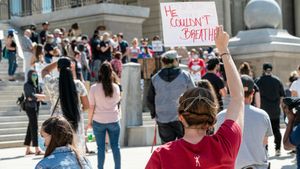During the early days of President Donald Trump's administration, the nation witnessed a slew of controversial policy actions and decisions marked by fierce criticism and legal challenges. The second week of February 2024, noted for its significant shifts, began ironically with the White House backing down from its directive to freeze federal spending on grants and loans, stirring disruptions among various organizations reliant on such funding.
Initial reports indicated Trump’s intentions to pause federal grants due to unfounded claims about diversity, equity, and inclusion (DEI) initiatives. The Type-A persistence over these issues was showcased when the Office of Management and Budget (OMB) issued memos to multiple federal agencies enforcing severe cuts to these programs, stirring outrage among advocacy groups and nonprofits.
The latest fallout from this pause was seen as particularly damaging to organizations serving vulnerable populations. CEOs of influential organizations like SAGE—a non-profit advocating for LGBTQ+ seniors—voiced grave concerns, labeling the freeze as reckless. Michael Adams, SAGE's CEO, stated, "This reckless decision puts entire communities at risk. We must work together now to protect our older neighbors, friends, and loved ones before it's too late." This stark warning from Adams underscored the potential harm to marginalized groups positioned precariously on the edge of stability.
The fallout did not stop there. Organizations like the National Council of Nonprofits quickly sprang to action, filing lawsuits against the Trump administration and demanding to retain funding necessary for their important work. Diane Yentel, President of the National Council of Nonprofits, called the directive "a reckless action" proving to be potentially catastrophic for communities dependent on such assistance, from shelters to health services, as she asserted, "From pausing research on cures for childhood cancer to halting housing and food assistance, the impact of even a short pause could cost lives.”
These strategies appeared to align with Trump's broader push against DEI programs. On the political front, Trump signed two executive orders aimed at prioritizing military excellence and addressing readiness. Defense Secretary Pete Hegseth was tasked to implement these measures within 30 days, hinting at imprinted loyalty over efficacy.
Shifting gears, the Trump administration’s efforts to reshape the federal workforce were not limited to financial freezes. Trump began movements to oust prosecutors involved with the January 6 Capitol riot, spurred on by resistance and backlash from within Congress. These tactics allowed Trump to construct political dominion over the Department of Justice (DOJ) and the FBI, consolidations often perceived as quintessential elements of authoritarian governance.
Adding to the tumultuous atmosphere was the significant role of Elon Musk, who began ingraining himself amid federal operations. Proposals for significant workforce downsizing and integrations of politically-aligned officials marked shift trends within government offices traditionally considered non-partisan.
Critics and civil liberties advocates decried these actions, seeing parallels drawn to similar maneuvers by authoritarian regimes worldwide. The backlash against Trump's initiatives was palpable—his hard-hitting words directed at diversity training and DEI programs echoed sentiments typically seen employed to target already marginalized communities.
Interestingly, the administration faced pushback not just from non-profit sectors but also from government officials. There were reports highlighting fears among agencies about the future viability of civil service protections. Federal workers grappled with uncertainty as resignations were suggested alongside paid leaves, effectively instilling trepidation about the future.
Though the administration attempted to paint its efforts as necessary for national security, the broader scope of each action betrayed authoritarian undertones. The utilization of executive orders—in effect, sidestepping legislative oversight—has stirred tensions within government, fueling narratives around unchecked presidential power bursting at the seams.
The third week of February saw Trump’s hardline trade policies come under scrutiny as tariffs on Canada and Mexico aimed to fortify national prospects but instead sparked predictions of retaliation and possible escalation of trade tensions. This too reflected the broader theme of disruption surrounding the administration’s early actions, with many Americans watching closely as the administration navigated unprecedented territories.
The broader narrative capturing these changes becomes increasingly troubling. With attempts at freezing funding, targeting DEI initiatives, and broadly reshaping federal institutions all at once, Trump's tactics have collectively shown alarming signs of consolidation of power, a tenet rooted deeply within the frameworks of authoritarian practices.
Now more than ever, advocacy groups are calling for intense activism and public oversight. The consequences for vulnerable communities hang precariously, underlining the need for collective action and accountability as the nation braces against disruptions posed by policies emanated from the executive branch.
Trump's early presidency is already characterized by clashes with established norms as he pushes through his agenda at every opportunity—a bold maneuver drawing sharp criticism and igniting fears of what such changes may entail for America moving forward.



